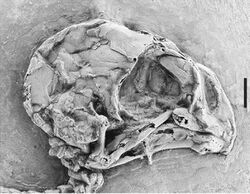Biology:Messelasturidae
| Messelasturidae | |
|---|---|

| |
| Tynskya eocaena | |
| Scientific classification | |
| Domain: | Eukaryota |
| Kingdom: | Animalia |
| Phylum: | Chordata |
| Class: | Aves |
| Clade: | Eufalconimorphae |
| Family: | †Messelasturidae Mayr 2005 |
| Genera | |
Messelasturidae is an extinct family of birds known from the Eocene of North America and Europe. Their morphology is a mosaic that in some aspects are very similar to modern hawks and falcons, but in others are more similar to parrots. Initially interpreted as stem-owls, more recent studies have suggested a closer relationship to parrots and passerines. Their ecology is enigmatic.
Description
On the skull, Messelasturidae possessed a raptorial beak and a large supraorbital process.[2]
On the feet, messelasturids lacked an ossified supratendineal bridge on the distal tibiotarsus.[3] They also featured raptorlike ungual phalanges.[4]
They were likely ground dwelling carnivores. They existed at an age range of 61.7 to 40.4 Ma.[5]
Tynskya is characterized by a distinctive morphology of the tarsometatarsus.[6]
Discovery and classification
Messelastur gratulator was originally described in 1994 from two skulls with associated vertebrae, found in the Eocene aged Messel pit, Germany.[7] Tynskya eocaena was described from specimens found in the Eocene aged Green River Formation in the western United States by Gerald Mayr in 2000, with indeterminate similar remains also being noted from the equivalently aged London Clay of southern England.[6] In 2005, a more complete skeleton of Messelastur was described, and it and Tynskya were placed into their own family Messelasturidae by Mayr, as the sister group of Strigiformes or possibly Falconiformes.[8] An additional specimen of Messelastur from Messel pit was described in 2011 by Mayr, finding that Messelasturidae was closely related to the extinct family Halcyornithidae, and both were likely stem-groups to Psittaciformes.[2] A study in 2021 described a new species of Tynskya, T. waltonensis from the London Clay. A phylogenetic analysis constrained to molecular data conducted in the study found messelasturids closely related to Psittacopasserae, the clade containing Passeriformes and Psittaciformes, but a sister group relationship with Halcyornithidae was not recovered.[9]
Ecology
Due to the mosaic nature of the morphology of messelasturids, their ecology is difficult to assess. It is likely they had a specialised feeding ecology. It is unlikely that they regularly searched the ground for food or engaged in hawking via sallying flights from perches. It is possible that they had a raptorial ecology, and hard shelled invertebrates have also been suggested as a food source, but other items like fruit and seeds cannot be ruled out.[9]
Distribution
Fossils of Messelastur are known from Germany (Messel). Tynskya remains have been found in the US (Green River Formation), and in the UK (London Clay), illustrating the resemblance between the early Eocene birds of North America and Europe.[6] Indeterminate messelasturid remains have also been reported from the early Eocene Nanjemoy Formation of Virginia in the United States.[10] An indeterminate bird from the Paleocene aged Menat maar deposit in France bears similarities to both Messelasturidae and Halcyornithidae.[1]
References
- ↑ 1.0 1.1 Mayr, Gerald; Hervet, Sophie; Buffetaut, Eric (2019). "On the diverse and widely ignored Paleocene avifauna of Menat (Puy-de-Dôme, France): new taxonomic records and unusual soft tissue preservation" (in en). Geological Magazine 156 (3): 572–584. doi:10.1017/S0016756818000080. ISSN 0016-7568. Bibcode: 2019GeoM..156..572M. https://www.cambridge.org/core/journals/geological-magazine/article/abs/on-the-diverse-and-widely-ignored-paleocene-avifauna-of-menat-puydedome-france-new-taxonomic-records-and-unusual-soft-tissue-preservation/1A1C7ABA9F83530F76C929185A651FC2.
- ↑ 2.0 2.1 Mayr, Gerald (2011-02-28). "Well-preserved new skeleton of the Middle Eocene Messelastur substantiates sister group relationship between Messelasturidae and Halcyornithidae (Aves, ?Pan-Psittaciformes)" (in en). Journal of Systematic Palaeontology 9 (1): 159–171. doi:10.1080/14772019.2010.505252. ISSN 1477-2019. http://www.tandfonline.com/doi/abs/10.1080/14772019.2010.505252.
- ↑ Mayr, Gerald (2005-09-30). [0635:TPOAPP2.0.CO;2 "The postcranial osteology and phylogenetic position of the Middle Eocene Messelastur gratulator Peters, 1994—a morphological link between owls (Strigiformes) and falconiform birds?"]. Journal of Vertebrate Paleontology 25 (3): 635–645. doi:10.1671/0272-4634(2005)025[0635:TPOAPP2.0.CO;2]. ISSN 0272-4634. https://doi.org/10.1671/0272-4634(2005)025[0635:TPOAPP]2.0.CO;2.
- ↑ Mayr, Gerald (March 2014). Smith, Andrew. ed. "The origins of crown group birds: molecules and fossils" (in en). Palaeontology 57 (2): 231–242. doi:10.1111/pala.12103. https://onlinelibrary.wiley.com/doi/10.1111/pala.12103.
- ↑ "Fossilworks: Messelasturidae". http://www.fossilworks.org/cgi-bin/bridge.pl?a=taxonInfo&taxon_no=206144.
- ↑ 6.0 6.1 6.2 Mayr, Gerald (2000-05-01). "A new raptor-like bird from the Lower Eocene of North America and Europe" (in en). Senckenbergiana Lethaea 80 (1): 59–65. doi:10.1007/BF03043664. ISSN 0037-2110. https://doi.org/10.1007/BF03043664.
- ↑ Peters, D.S. (1994) Messelastur gratulator n. gen. n. spec., ein Greifvogel as der Grube Messel (Aves: Accipitridae). Courier Forschungsinstitut Senckenberg, 170:3-9
- ↑ Mayr, Gerald (2005-09-30). "The postcranial osteology and phylogenetic position of the Middle Eocene Messelastur gratulator Peters, 1994—a morphological link between owls (Strigiformes) and falconiform birds?" (in en). Journal of Vertebrate Paleontology 25 (3): 635–645. doi:10.1671/0272-4634(2005)025[0635:TPOAPP2.0.CO;2]. ISSN 0272-4634. http://www.tandfonline.com/doi/abs/10.1671/0272-4634%282005%29025%5B0635%3ATPOAPP%5D2.0.CO%3B2.
- ↑ 9.0 9.1 Mayr, Gerald (2021-06-01). "A partial skeleton of a new species of Tynskya Mayr, 2000 (Aves, Messelasturidae) from the London Clay highlights the osteological distinctness of a poorly known early Eocene "owl/parrot mosaic"" (in en). PalZ 95 (2): 337–357. doi:10.1007/s12542-020-00541-8. ISSN 1867-6812.
- ↑ Mayr, Gerald; De Pietri, Vanesa; Paul Scofield, R. (2021-04-13). "New bird remains from the early Eocene Nanjemoy Formation of Virginia (USA), including the first records of the Messelasturidae, Psittacopedidae, and Zygodactylidae from the Fisher/Sullivan site" (in en). Historical Biology 34 (2): 322–334. doi:10.1080/08912963.2021.1910820. ISSN 0891-2963.
Wikidata ☰ Q2558536 entry
 |


